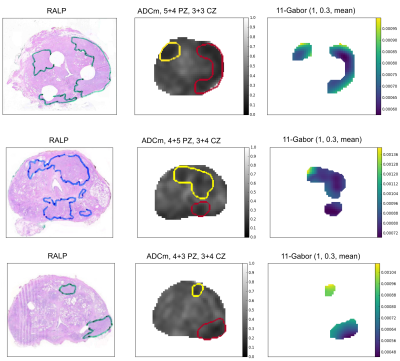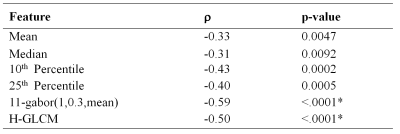2721
Computer aided quantification of prostate cancer diffusion-weighted imaging: repeatability analysis of radiomics as biomarkers for Gleason score prediction1Department of Future Technologies, University of Turku, Turku, Finland, 2Department of Diagnostic Radiology, University of Turku, Turku, Finland, 3Turku PET Centre, University of Turku, Turku, Finland, 4Department of Pathology, University of Turku and Turku University Hospital, Turku, Finland, 5Department of Urology, University of Turku and Turku University Hospital, Turku, Finland, 6Medical Imaging Centre of Southwest Finland, Turku University Hospital, Turku, Finland
Synopsis
We evaluated the repeatability of apparent diffusion coefficient, derived using monoexponential function (ADCm) from prostate cancer DWI (12 b values, 0-2000 s/mm2), radiomics of prostate cancer and their potential to predict prostate cancer Gleason score (histological grading system of prostate cancer aggressiveness). Statistical features (mean, median, 10th, 25th percentile) and Gabor texture feature of DWI ADCm parametric maps showed high repeatability and correlated significantly with Gleason score. In contrast, homogeneity gray-level co-occurrence matrix showed low repeatability despite having significant correlation with Gleason score.
Introduction
Prostate Cancer (PCa) is one of the most common cancers among men in United States.1 Although the number of PCa diagnosed cases is high, the proportion of PCa related deaths is substantially lower. The majority of men diagnosed with PCa have a non-aggressive tumor that rarely develops into a deathly disease. The aggressiveness of the tumor is commonly graded using a Gleason system.2 This system is used for biopsy and prostatectomy specimens. Correctly classifying tumors based on their Gleason score helps in planning patient treatment. However, Gleason score obtained from transrectal ultrasound-guided biopsies (TRUS) is inaccurate because of sampling error. Therefore, additional ways of predicting the tumor Gleason score are desired. Diffusion weighted imaging (DWI) have shown potential for non-invasive detection and characterization of PCa.3–9 It has been suggested that radiomics derived from apparent diffusion confident, derived using monoexponential function (ADCm), can have a role in Gleason score classification.10 However, repeatability of these approaches has not been evaluated. In this study, we assess the repeatability of ADCm derived radiomics and their potential to predict PCa Gleason score.Materials and Methods
The study was approved by the institutional review board and all patients provided written informed consent. A total of 55 patients with histologically confirmed PCa, scheduled for prostatectomy, were prospectively enrolled and underwent two prostate MR examinations performed on the same day. The DWI data sets were acquired using a 3T MR scanner (Ingenuity PET/MR, Philips, Cleveland, USA), SE-EPI sequence, monopolar diffusion gradient scheme, gradient overplus option on and the following parameters: TR/TE 3141 ms/51 ms, FOV 250×250 mm2, acquisition matrix 100x99, reconstruction matrix 224x224, slice thickness 5 mm, SENSE factor of 2, 12 b values of (number of signal averages) 0 (2), 100 (2), 300 (2), 500 (2) (2), 700 (2), 900 (2), 1100 (2), 1300 (2), 1500 (2), 1700 (3), 1900 (4), 2000 (4) s/mm2; diffusion time of 20.3 ms. The acquisition time was 8 min and 29 s. PCa lesions were delineated using whole mount prostatectomy sections as the “gold standard”. The first-order statistical features were obtained from the whole lesion ADCm histograms, these included mean, median, 10th and 25th percentile. Gabor texture was extracted using squared-shaped window of evenly spaced voxels (side length 11), frequency for the sinusoidal (f = 0.3), a circular Gaussian envelop (s = 1), and the mean of the real part. Homogeneity gray-level co-occurrence matrix (H-GLCM) feature was extracted using a minimum bonding box around the whole lesion on each slice, non-lesion voxels were excluded. The repeatability of the features was assessed using within-subject variance ($$$\sigma_w^2$$$), intraclass correlation coefficient (ICC) — specifically ICC(3,1)11 —, repeatability coefficient (RC) and within-subject coefficient of variation (wCV, %). Correlation of the features with Gleason score groups (3+3, 3+4, >3+4) was evaluated using Spearman correlation coefficient (ρ).Results
In total 47 patients (47/55, 86%) and 71 tumors were included in final analyses. Shapiro-Wilk normality test showed that the statistical features, Gabor, and the logarithm transformation of H-GLCM followed a normal distribution. Whole mount histopathologic sections (RALP), ADCm and texture maps of three patients are presented in Figure 1. A comparison of the ADCm features for all lesions is shown in Figure 2. All statistical features showed high repeatability with ICC values raging from 0.79 to 0.85, $$$\sigma_w^2$$$ from 3.9e-09 to 5.4e-09, RC from 1.7e-04 to 2.0e-04, and wCV from 6% to 9%. Gabor feature demonstrated high repeatability with ICC value of 0.80 (0.70 – 0.87), $$$\sigma_w^2$$$=4.4e-09, RC=1.8e-04 and wCV of 9% (Table 1). H-GLCM showed poor repeatability with ICC values of 0.35 (0.13 – 0.54) although statistically significant (p<0.0001) ρ value of -0.50. Gabor texture feature had the highest ρ value of -0.59 (p<0.0001) while the statistical features had ρ values in the range of -0.31 to -0.43 (Table 2).Discussion
To the best of our knowledge this is the first study evaluating repeatability of PCa DWI radiomics. We have shown that statistical features and Gabor texture feature have high repeatability and correlate significantly with PCa Gleason score. However, H-GLCM had significant correlation with PCa but failed to demonstrate high repeatability which is crucial in patient management of patients with clinically suspected or histologically confirmed PCa.Conclusion
Statistical features (mean, median, 10th, 25th percentile) and Gabor texture of DWI ADCm parameteric maps showed high repeatability and correlated significantly with Gleason score groups. In contrast, H-GLCM showed low repeatability. Our analyses suggest that Gabor texture feature has a potential to improve quantification of prostate DWI by providing high repeatability and improved Gleason score estimation.Acknowledgements
No acknowledgement found.References
1. Siegel RL, Miller KD, Jemal A. Cancer statistics, 2017. CA: A Cancer Journal for Clinicians. 2017;67(1):7–30.
2. Epstein JI, Allsbrook WCJ, Amin MB, Egevad LL. The 2005 International Society of Urological Pathology (ISUP) Consensus Conference on Gleason Grading of Prostatic Carcinoma. The American journal of surgical pathology. 2005;29(9):1228–1242.
3. Quentin M, Blondin D, Klasen J, Lanzman RS, Miese FR, Arsov C, Albers P, Antoch G, Wittsack HJ. Comparison of different mathematical models of diffusion-weighted prostate MR imaging. Magnetic Resonance Imaging. 2012;30(10):1468–1474.
4. Toivonen J, Merisaari H, Pesola M, Taimen P, Boström PJ, Pahikkala T, Aronen HJ, Jambor I. Mathematical models for diffusion-weighted imaging of prostate cancer using b values up to 2000 s/mm2: Correlation with Gleason score and repeatability of region of interest analysis. Magnetic Resonance in Medicine. 2015;74(4):1116–1124.
5. Boesen L, Chabanova E, Logager V, Balslev I, Thomsen HS. Apparent diffusion coefficient ratio correlates significantly with prostate cancer gleason score at final pathology. Journal of Magnetic Resonance Imaging. 2015;42(2):446–453.
6. Donati OF, Afaq A, Vargas HA, Mazaheri Y, Zheng J, Moskowitz CS, Hricak H, Akin O. Prostate MRI: Evaluating tumor volume and apparent diffusion coefficient as surrogate biomarkers for predicting tumor Gleason score. Clinical Cancer Research. 2014;20(14):3705–3711.
7. Jambor I, Merisaari H, Taimen P, Boström P, Minn H, Pesola M, Aronen HJ. Evaluation of different mathematical models for diffusion-weighted imaging of normal prostate and prostate cancer using high b-values: A repeatability study. Magnetic resonance in medicine. 2015;73(5):1988–1998.
8. Merisaari H, Jambor I. Optimization of b-value distribution for four mathematical models of prostate cancer diffusion-weighted imaging using b values up to 2000 s/mm2: Simulation and repeatability study. Magnetic resonance in medicine. 2015;73(5):1954–1969.
9. Jambor I, Pesola M, Merisaari H, Taimen P, Boström PJ, Liimatainen T, Aronen HJ. Relaxation along fictitious field, diffusion-weighted imaging, and T2 mapping of prostate cancer: Prediction of cancer aggressiveness. Magnetic resonance in medicine. 2016;75(5):2130–2140.
10. Fehr D, Veeraraghavan H, Wibmer A, Gondo T, Matsumoto K, Vargas HA, Sala E, Hricak H, Deasy JO. Automatic classification of prostate cancer Gleason scores from multiparametric magnetic resonance images. Proceedings of the National Academy of Sciences of the United States of America. 2015;112(46):E6265-73.
11. Shrout PE, Fleiss JL. Intraclass correlations: uses in assessing rater reliability. Psychological bulletin. 1979;86(2):420.
Figures



